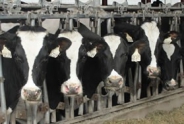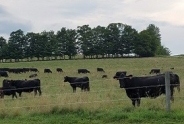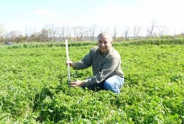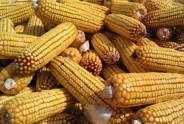Corn Silage Quality/Quantity Now Critical for Some...
David Balbian, Area Dairy Specialist
Central New York Dairy and Field Crops
Last Modified: May 9, 2014
Corn variation is tremendous. Some corn is far along and looks great. At the other extreme, some corn was planted the end of June or early July and will need the first killing frost to arrive in December for it to make it. Many fields with variable drainage are up and down in height and color, all depending on drainage. For many people this will be a year when segregating your corn silage, based on quality, could play an important role in your herds' performance this coming winter.
- high quality corn silage with good ear fill should be your mainstay supply for the milk cows
- corn silage that matured to at least half milk line or fields with high quality silage with minimal poor corn (poor ear fill or no ear) in the low spots should be your second quality priority
- earless corn should definitely be segregated for non-lactating animals.
So, what is corn silage worth on a per ton basis?
This is an especially important question for those buying all their feed (or at least the corn silage portion) and for those who have traditionally provided corn silage to long time customers. For the grower the issue is what the alternative value (corn grain) is per acre. For the buyer the issue is really what feed value corn silage brings to the table vs. other feed alternatives. Of course the high corn grain prices we have are at the root of this dilemma.
For the buyers of corn silage the feed alternatives are generally quite limited. Energy (or calories) in the form of starch is the primary nutrient that corn silage provides. Corn grain also provides this. The feeding alternatives to corn grain generally move up (or down) quickly to changing market conditions as feed companies (with sophisticated computer programs) search for cheaper supplies of nutrients. Prices of alternatives quickly adjust to reflect their nutrient value.
As I am writing, the corn grain price in Chicago is $6.90 a bushel. A variety of approaches to price corn silage based on corn grain prices end with a similar range of values.
Bruce Anderson, forage specialist from the University of Nebraska, offers up a simple approach to consider. Normally corn silage is half grain and half stover. At 65% moisture you have 700 lbs. of dry matter per ton. Half of that (350 lbs.) would be grain dry matter. One bushel of No, 2 corn weighs 56 lbs. 56 x .845 (15.5% moisture) = 47.32 lbs. of dry matter per bushel. 350 ? 47.32 = 7.4 bushels of grain per ton of silage. Multiply 7.4 x 6.90 = $51.06 for the grain alone. At the February 2011 Idaho Hay and Forage Association?s annual meeting he calculated the fertilizer value of the stover in one ton of 35% D.M. silage to be worth $6.04. Add that to the grain value and we get $57.10/ton.
Kern S. Hendrix, Department of Animal Science at Purdue states that a simple approach is to use 8 to 10 times the grain price per bushel to get in the ballpark. When grain price is over $3.00 a bushel us the lower range. For 35% D.M. silage the 8 times recommendations gives us $55.20/ton. An alternative method is to use the price/bushel times 7.4 bushels of grain per ton of silage along with $1 per 100 lbs. of silage D.M. (to account for stover value). This yields $62.20/ton.
Intricate details become more important in valuing corn silage, but practical issues and relationships are likely to prevail.
- Simple dry matter differences can really change the price per ton (assuming everything else is equal). If we use $50/ton for 35% D.M. C.S. and now have 30% D.M. silage the value per ton (as fed) would now be $42.86/ton. When C.S. was worth $25 to $40/ton the dry matter differences (although they were still there) were not as great.
- Who covers the fermentation losses? Nobody seems to be talking about this. Depending on what source you use, these losses range from 3% to 15%. A spreadsheet program from Iowa State university that is simple to use does take this one into account. You can access it at: www.extension.iastate.edu/agdm/crops/xls/a1-65cornsilagepricer.xls
- The grain content of corn silage is not always consistent. Information from the University of Missouri shows that typical grain content per ton ranges from 5 bushels with 89/bu/acre corn to 12 bushels with 180bu/acre corn. In addition, weather conditions during the growing season can also affect corn grain content.
- What about kernel processed corn? We know that in many case it can add to improved starch digestibility. How do we put a number on that one? In addition, a higher proportion of processed corn silage is harvested by custom operators. They often chop high (leave more stalk in the field) mostly to reduce the risk of damage from rocks in fields that are unfamiliar to them. This increases the grain percentage in the silage. Data from the Dairy One lab (from 5/1/00 to 4/30/11) in Ithaca shows average starch content of processed corn silage to be 33.572% vs. 31.595% in unprocessed corn silage.
- How about NDF digestibility? We know that higher NDF digestibility silage has a higher value. How do we factor that into the equation?
- Several computer spreadsheets are available to help determine the value of forages based on nutrient content. Here are a few:
FeedVal: www.uwex.edu/ces/dairynutrition/spreadsheets.cfm
SESAME: www.sesamesoft.com
The practical side of all of this is that corn silage (as well as corn grain) has increased in value because of market conditions. Items to consider:
- Local corn grain prices at harvest may not reflect the Chicago price. You should use local prices to determine value.
- If you are buying corn silage, but applying manure to the grower's fields the value of the manure should be subtracted from the price you pay.
- Sellers of corn silage may accept more modest prices from long standing customers to ensure that a good customer stays in business. Also, if you feel these high corn grain prices are not permanent a price break may be warranted to maintain that business relationship.
- Corn varieties now growing may be silage specific and not well suited for grain. This may limit the seller's options come harvest time.
- Late planting may result in some corn never maturing for grain. Silage may be the only harvest option.
- Good silage preservation practices will really pay off this year. The feed is too valuable to waste. Line bunker walls with plastic, consider the use of preservatives, consider investing in a silage facer (w/bunk silos), and be sure you achieve at least 14 to 15 lbs. of D.M. density/cu.ft.(on average) with bunk silos. Densities lower than that have high D.M. losses. Factors influencing this are: weight of the tractors(s) packing, feed layer thickness, number of tractors packing, dry matter content, and crop delivery rate. A spreadsheet to predict D.M. density is available at: http://www.uwex.edu/ces/ag/feedandcommoditystorage.html. Scroll down to the section on Silage Management and click on Bunker Silo Density Calculator (in English and Spanish).
Upcoming Events
2026 Dairy Day
January 13, 2026 : Dairy Day - Hamilton
Hamilton, NY
Lunch included
January 14, 2026 : Dairy Day - Ballston Spa
Ballston Spa, NY
Lunch included
2026 Corn & Soybean Day
January 20, 2026 : Corn & Soybean Day - Hamilton
Hamilton, NY
Lunch included. 2.75 DEC Credits available
January 21, 2026 : Corn & Soybean Day - Ballston Spa
Ballston Spa, NY
Lunch included. 2.75 DEC Credits available
Announcements
Statewide Field Crop Pathology Needs Assessment Survey
Your input is wanted for identifying priorities!Please take a moment to fill out this brief and anonymous survey that will guide the Field Crops Pathology Research and Extension program.
Sign Up for Our Weekly E-Newsletter
We send out a bi-weekly e-newsletter that has announcements, upcoming programs, and opportunities for you! Registration is quick, easy, and free. Click here to sign up today!Farmers Can Join MeatSuite For Free!
MeatSuite.com is a free resource provided by Cornell University where NY meat farmers can create a farm profile and list their bulk (wholes, halves, quarters) and bundled (i.e. Grilling Bundle) meat products.Why should farmers join?
1. It's free and easy!
2. Connect with more local customers. In the past year the MeatSuite.com farm directory had 8,300 visits from New York consumers. Farm profiles get as many as 25 views per month from potential local customers. We also spotlight MeatSuite farms on social media and bring attention and purchases to farms through highlights and giveaways.
How do I join?
Farmers can visit https://www.meatsuite.com/farmers/ to create a free farm profile. You must list at least one product for your farm's profile to go live. You'll also have access to Cornell's free Meat Price Calculator, a helpful tool for pricing your meat to make a profit.
While you're on MeatSuite, check out the "Creating Consumer-Friendly Bulk Meats" publication on the log-in page. It has tips on how to create bulk meat products that are easier for first-time buyers to say "yes" to.
If you have any questions as you create your farm profile or products, we're here to help! Please email Matt LeRoux at mnl28@cornell.edu.




